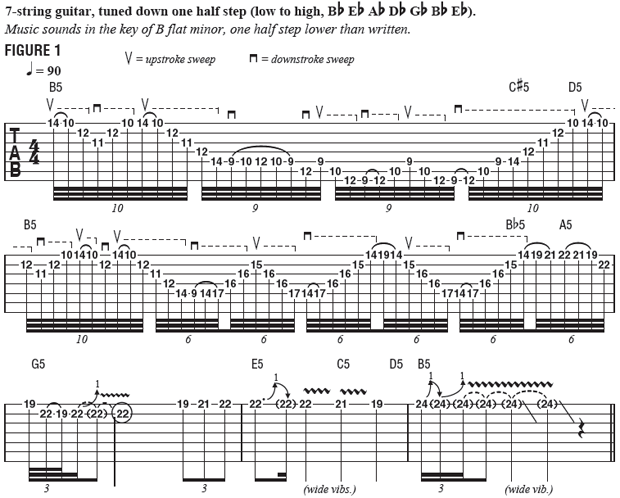Merchant of Menace with Jeff Loomis: Incorporating Sweep Arpeggios with Fast-Moving Position Shifts

This month, I ’d like to finish our analysis of the guitar solo from the title track of Nevermore’s latest release, The Obsidian Conspiracy, with a look at the last four bars of the solo, which carry into the first bar of the subsequent verse.
The majority of what I play during this section is built from sweep arpeggios of B minor triads (B D F#) that shift through a variety of positions. There’s a lot happening in this little four-bar section, so let’s get to it.
For this last section of the solo, illustrated in FIGURE 1, I’m playing over the same rhythm part that was illustrated in last month’s column.
As this rhythm part sits on the B minor “home” tonality for two full bars, it gives me plenty of room to explore fast-moving sweeps based on B minor triads: I begin in 10th position on the top three strings, quickly descending as I pull off with the pinkie on F#, first string/14th fret, to the index finger on D, first string/10th fret, followed by the middle finger on B, second string/12th fret.
The index finger then moves down to F#, third string/11th fret to complete the first descent, after which I ascend through the same series of notes, and then carry the subsequent descent back through the same note series all the way down to the fifth string in one long upstroke sweep.
FIGURE 2a illustrates this sweep in isolation; notice that the arpeggio covers three octaves, starting from a high F# (the fifth of B) and carrying through to F# two octaves lower. The nice thing about playing a seven-string is that it allows me to expand this downward sweeping pattern all the way down through another complete octave, culminating on a low F#, seventh string/ninth fret, as shown in FIGURE 2b.
If you put the pieces of both sweeps together, you get the complete 9th/10th position sweep shown in FIGURE 3. I recommend that you practice each of these elements with both upstroke and downstroke sweeps, starting slowly and concentrating on clear articulation when either dragging the pick across the strings.
All the latest guitar news, interviews, lessons, reviews, deals and more, direct to your inbox!
Looking back at FIGURE 1, you can see that I like to “cycle” smaller pieces of the arpeggios before expanding them across the majority of the strings. For example, I begin by repeating the small four-note/three-string sweep on the top three strings, and then, on beat three, I “cycle” the four-note/three-string sweep across the bottom three strings.
Then on beat four, I sweep back across all of the strings, from low to high. Bar 2 begins in a similar fashion to bar 1, but starting on the upbeat of beat two, with the index finger on F#, fifth string/ninth fret, I change positions by sliding the index finger up to B at the 14th fret, allowing me to initiate upward and downward sweeps across 14th position B minor triads, which I then “cycle” up and down across the top five strings.
On the upbeat of beat four in bar 2, I use the index finger once again for a quick position shift, sliding from F# at the 14th fret to the B root note at the 19th fret. Now situated in 19th position in bar 4, I wrap up the solo with more conventional B Aeolian type riffs, utilizing hammer-ons, pulloffs and bends for a legato sound, emphasizing very wide vibratos on each sustained note.
I tried to articulate a feeling of rhythmic freedom while executing all of these sweeps, thus the odd groupings of decuplets (10 notes played over one beat) and nonuplets (nine notes played over one beat) as well as pairs of 32nd note sextuplets (six notes) played over one beat.
The rhythmic precision of these groupings is less important than the effect created by crossing the strings in alternating sweeps very quickly, which takes a lot of practice to master.


